Geotechnical risk management to prevent coal outburst in room-and-pillar mining
Geotechnical Engineering and Soil Mechanics
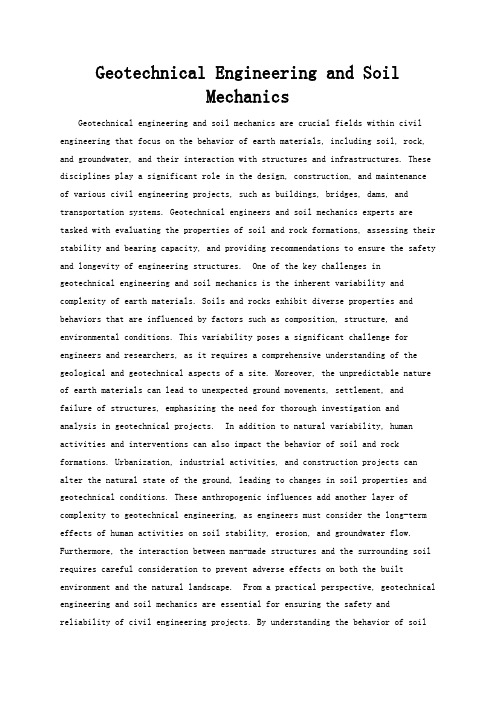
Geotechnical Engineering and SoilMechanicsGeotechnical engineering and soil mechanics are crucial fields within civil engineering that focus on the behavior of earth materials, including soil, rock, and groundwater, and their interaction with structures and infrastructures. These disciplines play a significant role in the design, construction, and maintenance of various civil engineering projects, such as buildings, bridges, dams, and transportation systems. Geotechnical engineers and soil mechanics experts are tasked with evaluating the properties of soil and rock formations, assessing their stability and bearing capacity, and providing recommendations to ensure the safety and longevity of engineering structures. One of the key challenges in geotechnical engineering and soil mechanics is the inherent variability and complexity of earth materials. Soils and rocks exhibit diverse properties and behaviors that are influenced by factors such as composition, structure, and environmental conditions. This variability poses a significant challenge for engineers and researchers, as it requires a comprehensive understanding of the geological and geotechnical aspects of a site. Moreover, the unpredictable nature of earth materials can lead to unexpected ground movements, settlement, andfailure of structures, emphasizing the need for thorough investigation and analysis in geotechnical projects. In addition to natural variability, human activities and interventions can also impact the behavior of soil and rock formations. Urbanization, industrial activities, and construction projects can alter the natural state of the ground, leading to changes in soil properties and geotechnical conditions. These anthropogenic influences add another layer of complexity to geotechnical engineering, as engineers must consider the long-term effects of human activities on soil stability, erosion, and groundwater flow. Furthermore, the interaction between man-made structures and the surrounding soil requires careful consideration to prevent adverse effects on both the built environment and the natural landscape. From a practical perspective, geotechnical engineering and soil mechanics are essential for ensuring the safety andreliability of civil engineering projects. By understanding the behavior of soiland rock formations, engineers can design foundations that can support the intended loads and prevent excessive settlement. Moreover, geotechnical investigations enable the identification of potential hazards, such as landslides, soil liquefaction, and groundwater seepage, allowing for the implementation of appropriate mitigation measures. In this way, geotechnical engineering serves as a fundamental component of risk management in construction and infrastructure development. Beyond the technical aspects, geotechnical engineering and soil mechanics also have significant implications for environmental sustainability and resource management. The extraction of natural resources, such as minerals and aggregates, often involves the disturbance of soil and rock formations, leading to land degradation and habitat destruction. Geotechnical considerations are therefore essential for minimizing the environmental impact of resource extraction activities and promoting responsible land use practices. Additionally, the management of contaminated sites and the remediation of polluted soils require a thorough understanding of geotechnical principles to ensure effective and sustainable solutions. In conclusion, geotechnical engineering and soil mechanics are indispensable disciplines within civil engineering, addressing the complex and dynamic nature of earth materials. The challenges and considerations in these fields extend beyond technical aspects, encompassing environmental, social, and ethical dimensions. As the demand for infrastructure continues to grow, the role of geotechnical engineering in ensuring the safety, sustainability, and resilience of civil engineering projects becomes increasingly critical. By embracing aholistic and multidisciplinary approach, geotechnical engineers and soil mechanics experts can contribute to the advancement of infrastructure development while safeguarding the natural environment and the well-being of communities.。
采矿工程英语面试及笔试资料

采矿工程英语面试及笔试资料Introduction:Mining engineering is a field that involves the extraction of valuable minerals or other geological materials from the earth. It requires a combination of technical skills, knowledge of geology, and an understanding of mining operations. This document provides a comprehensive guide for conducting interviews and written tests for candidates applying for mining engineering positions. The content is purely fictional and should be used for illustrative purposes only.1. Interview Questions:1.1 Technical Skills:1.1.1 Can you explain the process of mineral exploration and how it differs from mining?Answer: Mineral exploration involves searching for deposits of minerals in the ground. It includes geological mapping, geophysical surveys, and drilling to determine the presence and extent of mineral resources. Mining, on the other hand, involves extracting the minerals from the ground and processing them for various uses.1.1.2 What are the different methods of mining? Can you explain each briefly?Answer: There are several methods of mining, including underground mining, open-pit mining, placer mining, and mountaintop removal mining.- Underground mining involves extracting minerals from beneath the earth's surface, using tunnels and shafts.- Open-pit mining is the process of extracting minerals from a large, open excavation.- Placer mining involves extracting minerals from alluvial deposits, such as rivers or beach sands.- Mountaintop removal mining is a method used to extract coal by removing the summit of a mountain.1.1.3 How do you ensure the safety of mining operations?Answer: Safety is a top priority in mining operations. Measures such as regular inspections, proper training of workers, implementation of safety protocols, and use of protective equipment are crucial. Additionally, conducting risk assessments, maintaining proper ventilation, and monitoring gas levels are essential to ensure a safe working environment.1.2 Knowledge of Mining Regulations and Environmental Impact:1.2.1 Can you explain the role of mining regulations in the industry?Answer: Mining regulations are put in place to ensure responsible and sustainable mining practices. These regulations cover areas such as safety, environmental protection, labor rights, and community engagement. Compliance with these regulations is essential for maintaining the industry's social license to operate.1.2.2 How can mining operations minimize their environmental impact?Answer: Mining operations can minimize their environmental impact through various measures, including:- Implementing proper waste management and reclamation plans to restore the land after mining activities.- Using advanced technology and best practices to reduce air and water pollution.- Engaging in biodiversity conservation efforts and minimizing disturbance to ecosystems.- Promoting sustainable water management practices and reducing water usage.1.3 Problem-Solving and Analytical Skills:1.3.1 Can you provide an example of a challenging problem you encountered in a mining project and how you resolved it?Answer: During a mining project, we encountered a sudden increase in water inflow into the underground mine, which posed a significant risk to the safety of workers and the stability of the mine. To resolve this issue, we implemented emergency dewatering measures, including the installation of additional pumps and the reinforcement of underground support structures. We also conducted a thorough investigation to identify the root cause and implemented preventive measures to avoid such incidents in the future.1.3.2 How do you approach risk assessment in mining projects?Answer: Risk assessment is crucial in mining projects to identify potential hazards and develop strategies to mitigate them. I approach risk assessment by conducting comprehensive site inspections, analyzing historical data, and engaging with experts in geotechnical engineering and safety. By identifying potential risks early on, we can implement appropriate control measures to minimize their impact on the project.2. Written Test:2.1 Multiple Choice Questions:2.1.1 Which mining method involves extracting minerals from beneath the earth's surface?a) Open-pit miningb) Placer miningc) Underground miningd) Mountaintop removal mining2.1.2 What is the purpose of mining regulations?a) Ensuring maximum profitability for mining companiesb) Protecting the rights of mining workersc) Minimizing the environmental impact of mining operationsd) Promoting community engagement in mining projects2.1.3 What is the primary objective of risk assessment in mining projects?a) Maximizing the productivity of the mineb) Identifying potential hazards and developing strategies to mitigate themc) Reducing the cost of mining operationsd) Ensuring compliance with mining regulations2.2 Short Answer Questions:2.2.1 Define mineral exploration and explain its significance in the mining industry.Answer: Mineral exploration is the process of searching for deposits of minerals in the ground. It is significant in the mining industry as it helps identify the presence and extent of mineral resources, allowing mining companies to make informed decisions regarding the feasibility and profitability of mining projects.2.2.2 List three measures that mining operations can take to minimize their environmental impact.Answer: Mining operations can minimize their environmental impact by:- Implementing proper waste management and reclamation plans.- Using advanced technology and best practices to reduce pollution.- Engaging in biodiversity conservation efforts and minimizing disturbance to ecosystems.Conclusion:This comprehensive guide provides a framework for conducting interviews and written tests for candidates applying for mining engineering positions. It covers variousaspects, including technical skills, knowledge of mining regulations and environmental impact, and problem-solving abilities. Employers can use this guide as a reference to ensure a thorough evaluation of candidates' suitability for mining engineering roles.。
国际著名岩土工程SCI期刊中英文简介

1. Canadian Geotechnical Journal 加拿大岩土工程学报1963年开始出版,世界上发行量最大的三家岩土工程学术期刊之一,以刊登有关基础、隧道、水坝、边坡问题精彩文章及相关学科的新技术、新发展而闻名月刊SCI期刊ISSN : 1208-6010主编:Dr. Ian Moore, Queen's Universityhttp://pubs.nrc-cnrc.gc.ca/rp-ps ... de=cgj&lang=eng/ehost/d ... #db=aph&jid=35HPublished since 1963, this monthly journal features articles, notes, and discussions related to new developments in geotechnical and geoenvironmental engineering, and applied sciences. The topics of papers written by researchers, theoreticians, and engineers/scientists active in industry include soil and rock mechanics, material properties and fundamental behaviour, site characterization, foundations, excavations, tunnels, dams and embankments, slopes, landslides, geological and rock engineering, ground improvement, hydrogeology and contaminant hydrogeology, geochemistry, waste management, geosynthetics, offshore engineering, ice, frozen ground and northern engineering, risk and reliability applications, and physical and numerical modelling. Papers on actual case records from practice are encouraged and frequently featured.2. Geotechnical Engineering, Proceedings of ICE 岩土工程/journals/英国土木工程师协会(ICE)主办,集中了岩土工程实践中的所有方面内容,包括工程实例、工程设计讨论、计算机辅助设计等SCI期刊双月刊影响因子(2006): 0.286 ISSN 1353-2618 (Print) ISSN 1751-8563 (Online)Geotechnical Engineering covers all aspects of geotechnical engineering including tunnelling, foundations, retaining walls, embankments, diaphragm walls, piling, subsidence, soil mechanics and geoenvironmental engineering. Presented in the form of reports, design discussions, methodologies and case records it forms an invaluable reference work, highlighting projects which are interesting and innovative.Geotechnical Engineering publishes six issues per year.3. Géotechnique, Proceedings of ICE 土工国际著名的有关土力学、岩石力学、工程地质、环境岩土工程的岩土技术期刊,每期只刊登几篇文章,都是鸿篇巨著。
国际著名岩土类SCI期刊中英文简介

之前tangzhichengok 虫子发过一个【分享】岩土领域内几个SCI期刊,连接如下:/bbs/viewthread.php?tid=1754221我稍微做点补充吧!国际著名岩土类SCI期刊中英文简介转载请注明原出处:临峰山庄 详细介绍1. Canadian Geotechnical Journal加拿大岩土工程杂志,1963年开始出版,世界上发行量最大的三家岩土工程学术期刊之一,以刊登有关基础、隧道、水坝、边坡问题精彩文章及相关学科的新技术、新发展而闻名月刊SCI期刊主编:Dr. Ian Moore, Queen's Universityhttp://pubs.nrc-cnrc.gc.ca/rp-ps ... de=cgj&lang=eng/ehost/d ... #db=aph&jid=35Hmonthly ISSN : 1208-6010 影响因子Impact factor: 0.542NATL RESEARCH COUNCIL CANADA, RESEARCH JOURNALS,MONTREAL RD, OTTAWA, CANADA, K1A 0R6Published since 1963, this monthly journal features articles, notes, and discussions related to new developments in geotechnical and geoenvironmental engineering, and applied sciences. The topics of papers written by researchers, theoreticians, and engineers/scientists active in industry include soil and rock mechanics, material properties and fundamental behaviour, site characterization, foundations, excavations, tunnels, dams and embankments, slopes, landslides, geological and rock engineering, ground improvement, hydrogeology and contaminant hydrogeology, geochemistry, waste management, geosynthetics, offshore engineering, ice, frozen ground and northern engineering, risk and reliability applications, and physical and numerical modelling. Papers on actual case records from practice are encouraged and frequently featured.更多资讯请上浏览2. Geotechnical Engineering, Proceedings of ICE/journals/英国土木工程师协会(ICE)主办,集中了岩土工程实践中的所有方面内容,包括工程实例、工程设计讨论、计算机辅助设计等SCI期刊双月刊影响因子(2006): 0.286 Geotechnical Engineering covers all aspects of geotechnical engineering including tunnelling, foundations, retaining walls, embankments, diaphragm walls, piling, subsidence, soil mechanics and geoenvironmental engineering.Presented in the form of reports, design discussions, methodologies and case records it forms an invaluable reference work, highlighting projects which are interesting and innovative.Geotechnical Engineering publishes six issues per year.ISSN 1353-2618 (Print)ISSN 1751-8563 (Online)Impact Factor (2006): 0.2863. Géotechnique, Proceedings of ICE国际著名的有关土力学、岩石力学、工程地质、环境岩土工程的岩土技术期刊,每期只刊登几篇文章,都是鸿篇巨著。
土木工程英语翻译
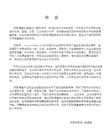
The error due to measurement error for each strain and the location of the measuring line, the results may deviate from the linear assumption.
14、然而,与其他结构荷载相比,恒载变化是相对较小的,实际平均值与规范规定的值很接近。
However,compared to the other structural loads,the dead load variations are relatively small,and the actual mean values are quite close to the code-prescribed data.
An earthquake is the vibratory movement of the earth's surface that follows a sudden release of energy in the crust.
32、结构设计中,对于地震作用主要应注意的是结构对地面运动的响应。
20、中性轴下方混凝土中的拉应力很低,而且其内力臂也很小。
Tensile stress in the concrete below the neutral axis is very low, and the lever arm is also very small.
21、岩土工程师需要解决的最困难的问题可能就是准确预测地基在荷载作用下的荷载。
A system of forces is said to be in equilibrium when the resultant of all the forces and the resultant of all the moments at one point are equal to zero.
中考英语投资理财的风险防范措施单选题40题
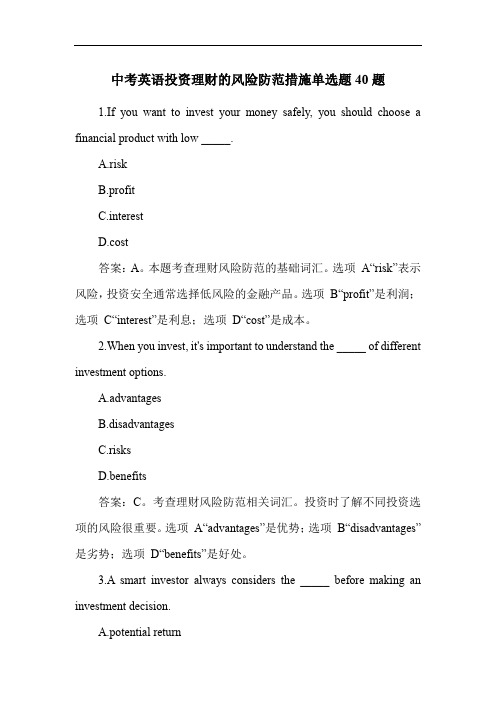
中考英语投资理财的风险防范措施单选题40题1.If you want to invest your money safely, you should choose a financial product with low _____.A.riskB.profitC.interestD.cost答案:A。
本题考查理财风险防范的基础词汇。
选项A“risk”表示风险,投资安全通常选择低风险的金融产品。
选项B“profit”是利润;选项C“interest”是利息;选项D“cost”是成本。
2.When you invest, it's important to understand the _____ of different investment options.A.advantagesB.disadvantagesC.risksD.benefits答案:C。
考查理财风险防范相关词汇。
投资时了解不同投资选项的风险很重要。
选项A“advantages”是优势;选项B“disadvantages”是劣势;选项D“benefits”是好处。
3.A smart investor always considers the _____ before making an investment decision.A.potential returnB.possible lossC.market trendD.investment strategy答案:B。
涉及理财风险防范词汇。
聪明的投资者在做投资决定前总会考虑可能的损失。
选项A“potential return”是潜在回报;选项C“market trend”是市场趋势;选项D“investment strategy”是投资策略。
4.Investment products with high returns usually come with high _____.A.risksB.profitsC.interestsD.costs答案:A。
岩土

岩土与环境岩土工程Geotechnical engineering and geoenvironmental engineering,这个学科分支与其它学科密不可分,不像结构那样比较独立。
岩土工程简称就是研究土的学科,是包括地上与地下的土的研究,因此也与地质学,水利学科有关,有的也涉及到Geoinformatics,因此研究范围比较广泛,要深入了解透也比较难。
目前岩土工程学科发展还不是很完善,但是现在研究也有点止步不前的感觉,这与这个学科研究的本身有关,土在自然界分布中具有不均匀性,不确定性,以及地域性,所以造成学科的发展受很多因素限制。
与其说其是一门科学,而不入说是一门实际应用。
从这门学科创立至今,很多公式与定理都是定性而成,甚至是假设,反倒假设作的很好。
而不像数学物理化学等学科具有非常准确性和精确度,这门学科的误差甚至20% 都是可以被接受的。
1.学科发展这门学科的发展源于欧洲,其实最早在中国,只是欧洲以公式化定义了一些物理量,并且很快流通起来。
Terzaghi于1920S编写了本学科的第一本教科书最初的研究发展主要停留在运用基本土工测试仪器测试土体(无粘性土如砂土,粘性土如粘土)的抗剪强度,为土坡以及地基基础等比较实际的工程设计提供计算参数。
当年U.S. Army也就是大家熟知的美国陆军设计团为了当时战备需要,需要建立大量的土工建筑物,因此土工设计也显得尤其重要。
2.目前研究热点本专业的研究归属性特别强,即分类型,各自导师培养的新的faculty基本上延续了本导师之前的研究方向,并且不断发扬光大,创造新的学科增长点。
大概研究方向如下:(a) Soil Characteristics and Laboratory Testing,(b) Foundations Engineering;(c) Excavation and Earth Retaining Structures;(d) Slope stability;(e) Geoenrionmental related-topics;(f) Soil Dynamics and Earthquake Engineering;(g) Ground Improvement and Geosynthentics;(h) Unsaturated Soils由于土木发展比较好的学校本来就比较少,不像计算机等学科只要是个学科就有的,比如本学科在YALE,HAVARD,CALTECH本学科基本灭迹,虽然上世纪30年代曾经有过。
深基坑方案评审流程

深基坑方案评审流程Deep foundation pit project review is a crucial process in ensuring the safety and effectiveness of construction projects. 深基坑工程评审是确保建筑工程安全和有效性的关键过程。
It involves a comprehensive assessment of the design, construction method, and risk management strategies proposed for excavating and retaining deep excavations. 这涉及对设计、施工方法以及用于挖掘和支护深基坑的风险管理策略的全面评估。
As such, the review process should be thorough, collaborative, and transparent to address any potential issues before they escalate into costly problems. 因此,评审过程应该深入、协作并且透明,以应对潜在问题,避免它们升级为成本高昂的问题。
One of the key aspects of the deep foundation pit project review process is the evaluation of the project's design and engineering plans. 深基坑工程评审过程的关键方面之一是对项目的设计和工程计划进行评估。
This involves scrutinizing the structural stability, load-bearing capacity, and soil conditions to ensure that the proposed excavation and retention measures are appropriate and safe. 这涉及审查结构稳定性、承载能力和土壤条件,以确保提出的挖掘和支护措施是合适和安全的。
国际著名岩土力学、工程地质学报(期刊)索引

国际著名岩土力学、工程地质学报(期刊)索引?国际著名岩土力学、工程地质学报(期刊)索引1.《Engineering Geology》——An International Journal, Elsevier------------《工程地质》——国际学报2.《The Quarterly Journal of Engineering Geology》,U.K.---------------------《工程地质季刊学报》3.《News Journal, International Society for Rock Mechanics》-----------《国际岩石力学学会信息学报》4.《International Journal of Rock Mechanics and Mining Sciences》---------《国际岩石力学与矿业科学学报》(包括岩土力学文摘)5.《Rock Mechanics and Rock Engineering》----------------------------《岩石力学与岩石工程》6.《Felsbau》[G.]---------------------------------《岩石力学》,奥地利地质力学学会(AGG)主办7. Geomechnik and Tunnelbau (G.)——Geomechanics and Tunnelling---------------《地质力学与隧道工程》——奥地利地质力学学会(ACC)主办8.《GEOTECHNIGUE》-------------------------------------《岩土力学》,英国土木工程师学会ICE主办9.《Journal of Geotechnical & Geoenvironmental Engineering》(formerly Journal of Geotechnical Engineering)????? -----------岩土工程与环境岩土工程学报》,改版前称《岩土工程学报》,美国土木工程师学会ASCE主办。
危岩崩塌防治技术体系及工程选型分析

钻探工程Drilling Engineering第51卷第2期2024年3月Vol. 51 No. 2Mar. 2024:108-118危岩崩塌防治技术体系及工程选型分析周云涛1,2,吴 波*1,3,蔡强1,2,梁炯1,2(1.中国地质科学院探矿工艺研究所,四川 成都 611734; 2.自然资源部地质灾害风险防控工程技术创新中心,四川 成都 611734;3.成都华建地质工程科技有限公司,四川 成都 611734)摘要:危岩崩塌防治技术是保障危岩工程安全稳定的关键。
通过对危岩崩塌防治技术的优缺点、适用条件、工程设置原则以及选型程序的分析,认为危岩崩塌防治技术可分为主动防治技术、被动防治技术和辅助防治技术,各项防治技术设计时应充分考虑其适用条件,按照工程设置原则采纳使用,适时选择多种技术组合方式的治理措施进行危岩崩塌工程防治;危岩崩塌防治技术选型应遵循查清危岩体基本情况→评价危岩体状态→选择危岩防治技术→分析防治技术选型结果的基本程序,确定危岩崩塌防治技术选型程序各环节的关键参数,以确定合适的崩塌防治技术。
研究成果可为危岩崩塌防治工程设计提供理论依据和关键技术支撑。
关键词:危岩崩塌;防治技术体系;选型程序;主动防治技术;被动防治技术;辅助防治技术中图分类号:P642.21;P634 文献标识码:A 文章编号:2096-9686(2024)02-0108-11Analysis of control and prevention technology system andengineering selection for unstable‑rockZHOU Yuntao 1,2,WU Bo *1,3,CAI Qiang 1,2,LIANG Jiong 1,2(1. Institute of Exploration Technology, CAGS, Chengdu Sichuan 611734, China ;2. Technology Innovation Center for Risk Prevention and Mitigation of Geohazard, MNR, Chengdu Sichuan 611734, China;3. Chengdu Huajian Geological Engineering Technology Co., Ltd., Chengdu Sichuan 611734, China )Abstract : The control and prevention technology for unstable‑rock is the key to guarantee the safety and stability of unstable‑rock. This paper analyzed the merit and demerit , application condition , engineering setting principle and selection program of the control and prevention technology , which is devided into three kinds , i.e., active technology , passive technology and assisted technology. Application conditions of each technology should be considered when these technologies were designed. Each technology should be selected based on the engineering setting principle , and the treatment measure with multiple technologies to control and prevent unstable‑rock should be duly selected. The selection of technology for unstable‑rock engineering should follow such process of checking the basic information of unstable‑rock → evaluating the state of unstable‑rock → selecting technology → analyzing the result of selected technology , thus the key parameters of each part of this process were confirmed to select the suitable technology. This research achievement could provide the theoretical foundation and key technology support for unstable‑rock engineering.Key words : unstable‑rock collapse; control and prevention system; selection process; active technology; passive technology;assisted technology收稿日期:2023-07-22; 修回日期:2023-11-03 DOI :10.12143/j.ztgc.2024.02.015基金项目:中国地质调查局地质调查项目“高陡碎屑坡生态治理技术应用示范”(编号:DD20230450);国家重点研发计划专项项目“膨胀土滑坡和工程边坡防护工程健康诊断和快速修复技术”(编号:2019YFC1509904)第一作者:周云涛,男,汉族,1988年生,工程师,地质工程专业,博士,从事岩土与地质工程减灾机理及防控技术研究工作,四川省成都市郫都区港华路139号,**********************。
伊利诺伊大学香槟分校土木工程项目介绍【时代兴华留学】
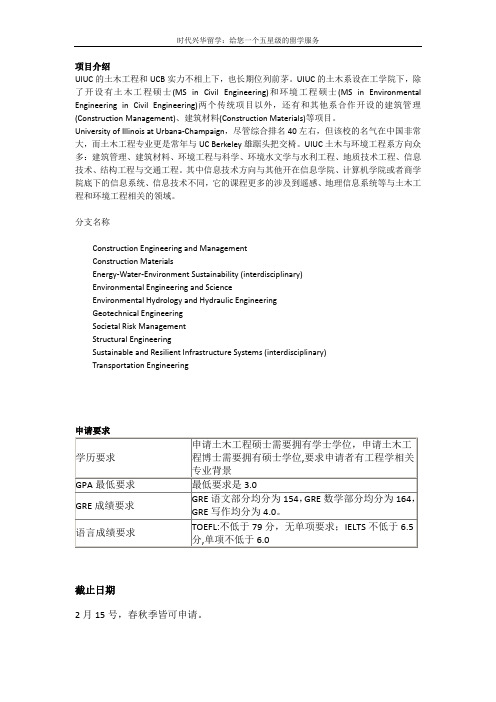
UIUC的土木工程和UCB实力不相上下,也长期位列前茅。
UIUC的土木系设在工学院下,除了开设有土木工程硕士(MS in Civil Engineering)和环境工程硕士(MS in Environmental Engineering in Civil Engineering)两个传统项目以外,还有和其他系合作开设的建筑管理(Construction Management)、建筑材料(Construction Materials)等项目。
University of Illinois at Urbana-Champaign,尽管综合排名40左右,但该校的名气在中国非常大,而土木工程专业更是常年与UC Berkeley雄踞头把交椅。
UIUC土木与环境工程系方向众多:建筑管理、建筑材料、环境工程与科学、环境水文学与水利工程、地质技术工程、信息技术、结构工程与交通工程。
其中信息技术方向与其他开在信息学院、计算机学院或者商学院底下的信息系统、信息技术不同,它的课程更多的涉及到遥感、地理信息系统等与土木工程和环境工程相关的领域。
分支名称Construction Engineering and ManagementConstruction MaterialsEnergy-Water-Environment Sustainability (interdisciplinary)Environmental Engineering and ScienceEnvironmental Hydrology and Hydraulic EngineeringGeotechnical EngineeringSocietal Risk ManagementStructural EngineeringSustainable and Resilient Infrastructure Systems (interdisciplinary)Transportation Engineering申请要求截止日期2月15号,春秋季皆可申请。
国际著名岩土工程SCI期刊英文

1. Canadian Geotechnical Journal 加拿大岩土工程学报1963年开始出版,世界上发行量最大的三家岩土工程学术期刊之一,以刊登有关基础、隧道、水坝、边坡问题精彩文章及相关学科的新技术、新发展而闻名月刊SCI期刊ISSN : 1208-6010主编:Dr. Ian Moore, Queen's Universityhttp://pubs.nrc-cnrc.gc.ca/rp-ps ... de=cgj&lang=eng/ehost/d ... #db=aph&jid=35HPublished since 1963, this monthly journal features articles, notes, and discussions related to new developments in geotechnical and geoenvironmental engineering, an d applied sciences. The topics of papers written by researchers, theoreticians, and engineers/scientists active in industry include soil and rock mechanics, material prop erties and fundamental behaviour, site characterization, foundations, excavations, tu nnels, dams and embankments, slopes, landslides, geological and rock engineering, ground improvement, hydrogeology and contaminant hydrogeology, geochemistry, w aste management, geosynthetics, offshore engineering, ice, frozen ground and north ern engineering, risk and reliability applications, and physical and numerical modelli ng. Papers on actual case records from practice are encouraged and frequently fea tured.2. Geotechnical Engineering, Proceedings of ICE 岩土工程/journals/英国土木工程师协会(ICE)主办,集中了岩土工程实践中的所有方面内容,包括工程实例、工程设计讨论、计算机辅助设计等SCI期刊双月刊影响因子(2006): 0.286 ISSN 1353-2618 (Print) ISSN 1751-8563 (Online)Geotechnical Engineering covers all aspects of geotechnical engineering including tu nnelling, foundations, retaining walls, embankments, diaphragm walls, piling, subside nce, soil mechanics and geoenvironmental engineering. Presented in the form of re ports, design discussions, methodologies and case records it forms an invaluable re ference work, highlighting projects which are interesting and innovative. Geotechnical Engineering publishes six issues per year.3. Géotechnique, Proceedings of ICE 土工国际著名的有关土力学、岩石力学、工程地质、环境岩土工程的岩土技术期刊,每期只刊登几篇文章,都是鸿篇巨著。
地质灾害评估 质量管理制度
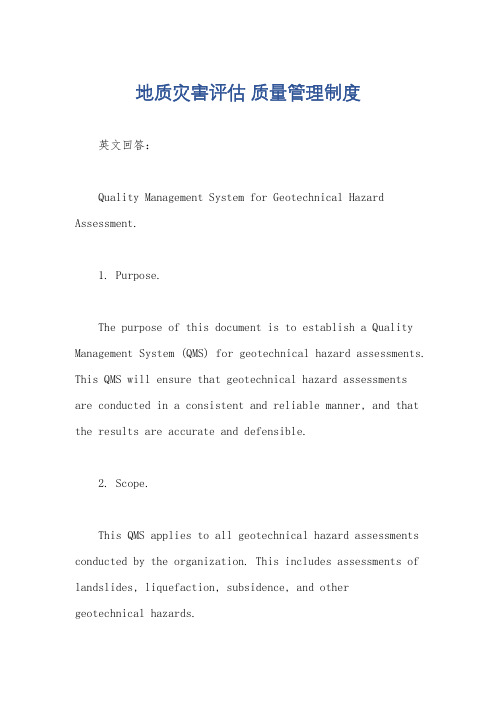
地质灾害评估质量管理制度英文回答:Quality Management System for Geotechnical Hazard Assessment.1. Purpose.The purpose of this document is to establish a Quality Management System (QMS) for geotechnical hazard assessments. This QMS will ensure that geotechnical hazard assessments are conducted in a consistent and reliable manner, and that the results are accurate and defensible.2. Scope.This QMS applies to all geotechnical hazard assessments conducted by the organization. This includes assessments of landslides, liquefaction, subsidence, and othergeotechnical hazards.3. Definitions.Geotechnical hazard assessment: A study that evaluates the potential for geotechnical hazards at a site.Quality Management System (QMS): A set of policies, procedures, and practices that are used to ensure that an organization's products and services meet customer requirements.Accuracy: The degree to which a measurement or estimate conforms to the true value.Reliability: The degree to which a measurement or estimate can be repeated under the same conditions.Defensibility: The ability to support a conclusion or decision with evidence.4. Policies.The organization is committed to conducting geotechnical hazard assessments in a consistent andreliable manner.The organization will use the latest available techniques and methods to conduct geotechnical hazard assessments.The organization will ensure that all geotechnical hazard assessments are reviewed by a qualified professional.The organization will maintain a record of all geotechnical hazard assessments.5. Procedures.Geotechnical hazard assessments will be conducted in accordance with the following steps:Site reconnaissance: A site reconnaissance will be conducted to identify potential geotechnical hazards.Data collection: Data will be collected to characterize the site conditions. This data will include subsurface exploration, laboratory testing, and aerial photography.Hazard analysis: The data will be analyzed to identify potential geotechnical hazards.Risk assessment: The potential geotechnical hazards will be assessed to determine their risk to life and property.Mitigation measures: Mitigation measures will be developed to reduce the risk of geotechnical hazards.Geotechnical hazard assessments will be reviewed by a qualified professional: The geotechnical hazard assessment will be reviewed by a qualified professional to ensure that it is accurate, reliable, and defensible.Records of geotechnical hazard assessments will be maintained: The organization will maintain a record of allgeotechnical hazard assessments. These records will include the following information:Site location: The location of the site where the geotechnical hazard assessment was conducted.Date of assessment: The date the geotechnical hazard assessment was conducted.Personnel involved: The personnel who conducted the geotechnical hazard assessment.Scope of work: The scope of work for the geotechnical hazard assessment.Results of assessment: The results of the geotechnical hazard assessment.Recommendations: The recommendations from the geotechnical hazard assessment.6. Responsibilities.The following personnel are responsible for implementing this QMS:Project manager: The project manager is responsible for ensuring that the geotechnical hazard assessment is conducted in accordance with this QMS.Geotechnical engineer: The geotechnical engineer is responsible for conducting the geotechnical hazard assessment.Quality assurance manager: The quality assurance manager is responsible for reviewing the geotechnical hazard assessment and ensuring that it is accurate, reliable, and defensible.7. Training.All personnel involved in conducting geotechnical hazard assessments will be trained on this QMS. The training will include the following topics:The purpose of this QMS.The scope of this QMS.The policies of this QMS.The procedures of this QMS.The responsibilities of personnel involved in conducting geotechnical hazard assessments.8. Audits.The QMS will be audited on a regular basis to ensure that it is being implemented effectively. The audits will be conducted by the quality assurance manager.9. Continuous Improvement.The organization is committed to continuous improvement of the QMS. The QMS will be reviewed on aregular basis and updated as needed to ensure that it is effective and efficient.中文回答:地质灾害评估质量管理制度。
基坑专家论证建设单位发言稿
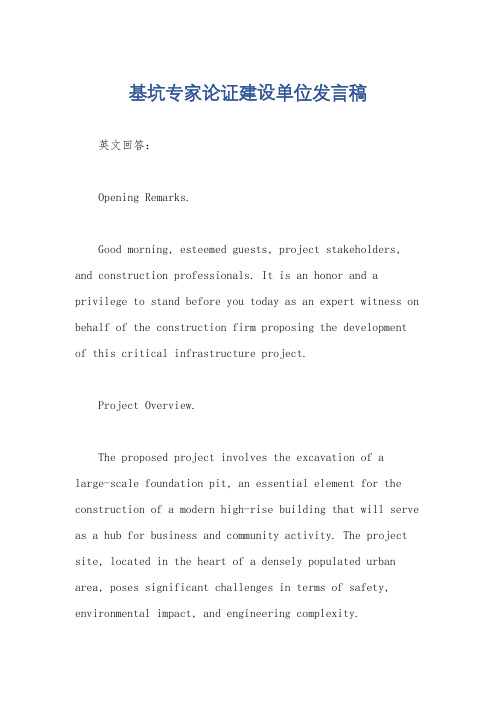
基坑专家论证建设单位发言稿英文回答:Opening Remarks.Good morning, esteemed guests, project stakeholders, and construction professionals. It is an honor and a privilege to stand before you today as an expert witness on behalf of the construction firm proposing the development of this critical infrastructure project.Project Overview.The proposed project involves the excavation of alarge-scale foundation pit, an essential element for the construction of a modern high-rise building that will serve as a hub for business and community activity. The project site, located in the heart of a densely populated urban area, poses significant challenges in terms of safety, environmental impact, and engineering complexity.Expertise and Qualifications.As a highly experienced foundation engineering expert with over two decades of specialized knowledge, I have been retained to provide professional guidance and support throughout this project. My expertise encompasses the design, planning, and construction of foundation pits, ensuring that all technical aspects comply with industry standards and best practices.Technical Justification.The proposed foundation pit design has been meticulously engineered to meet the unique geotechnical conditions of the project site. Detailed investigations, including soil testing and geological surveys, have been conducted to ascertain the soil's stability, bearing capacity, and potential risks. The design incorporates advanced techniques to minimize ground movement, prevent groundwater infiltration, and safeguard the surrounding environment.Safety and Environmental Mitigation.Safety is paramount in all aspects of this project. The proposed excavation plan includes comprehensive measures to ensure the well-being of workers, the public, and neighboring properties. These measures include:Design of temporary excavation support systems, such as sheet piles and diaphragm walls, to prevent ground collapse and soil erosion.Installation of robust drainage systems to control groundwater and surface water, minimizing the risk of flooding and soil saturation.Implementation of strict traffic management plans to mitigate disruptions to the surrounding community and ensure safe access for construction vehicles.Adherence to environmental regulations and best practices to protect air and water quality, noise levels,and ecological integrity.Construction Timeline and Quality Control.The construction schedule has been carefully planned to minimize disruption and ensure timely completion. The project team will employ proven excavation techniques and cutting-edge equipment to expedite the excavation process. Rigorous quality control measures will be implemented at every stage to verify that the foundation pit meets the design specifications and industry standards.Conclusion.The construction of this foundation pit is a critical step towards the realization of a transformative infrastructure project. The proposed design, technical expertise, and commitment to safety and environmental mitigation make this project a sound investment for the community. I urge you to approve the construction plan, paving the way for a sustainable and resilient development that will benefit the city and its residents forgenerations to come.中文回答:开场白。
epc模式英语单词
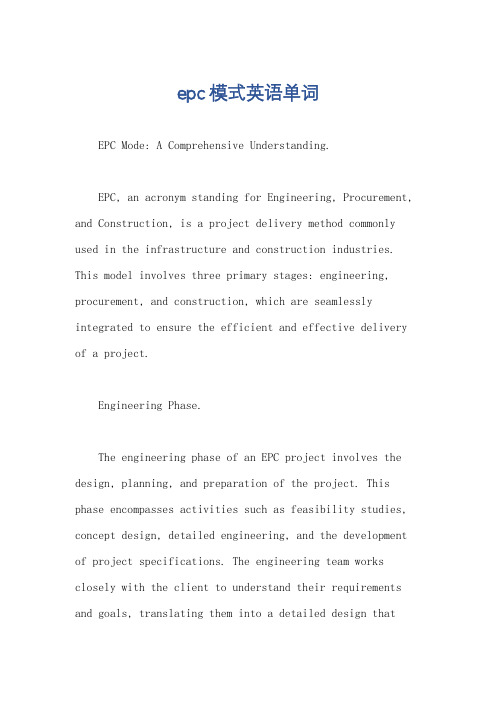
epc模式英语单词EPC Mode: A Comprehensive Understanding.EPC, an acronym standing for Engineering, Procurement, and Construction, is a project delivery method commonly used in the infrastructure and construction industries. This model involves three primary stages: engineering, procurement, and construction, which are seamlessly integrated to ensure the efficient and effective delivery of a project.Engineering Phase.The engineering phase of an EPC project involves the design, planning, and preparation of the project. This phase encompasses activities such as feasibility studies, concept design, detailed engineering, and the development of project specifications. The engineering team works closely with the client to understand their requirements and goals, translating them into a detailed design thatmeets the specified standards and budget.During this phase, the engineering team also identifies and mitigates potential risks, ensuring the project's viability and success. They consider factors like geotechnical conditions, environmental impacts, and safety regulations to create a design that is not only aesthetically pleasing but also structurally sound and environmentally responsible.Procurement Phase.The procurement phase is concerned with sourcing and acquiring the materials, equipment, and services required for the project. This involves market research, vendor selection, negotiation of contracts, and the management of supply chains. The procurement team works closely with suppliers to ensure the timely delivery of quality products and services at competitive prices.During this phase, the procurement team also manages risks related to supply chain disruptions, pricefluctuations, and non-compliance with specifications. They ensure that all procured items meet the project's requirements and are delivered on time, minimizing delays and cost overruns.Construction Phase.The construction phase is the physical implementation of the design, where the actual building or infrastructure takes shape. This phase involves site preparation, excavation, foundation works, structural construction, and the installation of mechanical, electrical, and plumbing systems.The construction team, led by a project manager, oversees the execution of the works, ensuring they align with the design and specifications. They manage resources, monitor progress, and address any challenges that arise during the construction process. Safety is a paramount concern during this phase, and the team implements strict safety measures to prevent accidents and injuries.Integration of Phases.The key to the success of an EPC project lies in the seamless integration of the engineering, procurement, and construction phases. Close collaboration and communication between the teams involved are essential to ensure that the project flows smoothly from one phase to the next. Regular meetings, reviews, and updates keep everyone informed about the project's progress, challenges, and opportunities.Moreover, an EPC contractor typically assumes responsibility for the overall project performance, including cost, time, and quality. This arrangement allows the client to delegate the execution of the project to a single responsible party, reducing the need for multiple contracts and interfaces.Advantages of EPC Mode.There are several advantages to using the EPC mode for project delivery. Firstly, it offers a single-point responsibility, which simplifies project management andreduces the risk of finger-pointing and disputes between different parties. Secondly, the integrated approach allows for better coordination and synchronization between the various phases of the project, leading to improved efficiency and reduced waste.Additionally, the EPC model encourages early engagement of all stakeholders, including designers, suppliers, and constructors, which can lead to innovative solutions and cost savings. It also facilitates risk mitigation throughout the project lifecycle, ensuring that potential issues are identified and addressed promptly.Challenges of EPC Mode.However, the EPC model also presents some challenges. Firstly, the client may lack direct control over the design and procurement processes, which can lead to a lack of transparency and difficulty in making changes once the project has begun. Secondly, the success of the project heavily depends on the EPC contractor's capabilities and experience, which can pose a risk if the contractor isinexperienced or under-resourced.Moreover, the integrated nature of the EPC model can make it difficult to separate out individual phases for bidding or tendering purposes. This can limit competition and potentially lead to higher costs.Conclusion.The EPC model offers a comprehensive and integrated approach to project delivery, with clear advantages in terms of efficiency, cost-effectiveness, and risk mitigation. However, it also poses some challenges that need to be carefully managed to ensure the project's success. By understanding the intricacies of the EPC model and engaging experienced and capable contractors, clients can leverage this model to deliver infrastructure and construction projects that meet their requirements and expectations.。
欧美注册岩土工程师制度
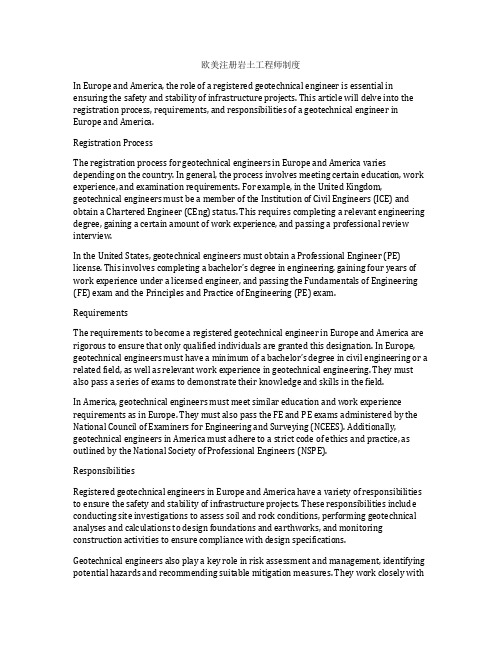
欧美注册岩土工程师制度In Europe and America, the role of a registered geotechnical engineer is essential in ensuring the safety and stability of infrastructure projects. This article will delve into the registration process, requirements, and responsibilities of a geotechnical engineer in Europe and America.Registration ProcessThe registration process for geotechnical engineers in Europe and America varies depending on the country. In general, the process involves meeting certain education, work experience, and examination requirements. For example, in the United Kingdom, geotechnical engineers must be a member of the Institution of Civil Engineers (ICE) and obtain a Chartered Engineer (CEng) status. This requires completing a relevant engineering degree, gaining a certain amount of work experience, and passing a professional review interview.In the United States, geotechnical engineers must obtain a Professional Engineer (PE) license. This involves completing a bachelor’s degree in engineering, gaining four years of work experience under a licensed engineer, and passing the Fundamentals of Engineering (FE) exam and the Principles and Practice of Engineering (PE) exam.RequirementsThe requirements to become a registered geotechnical engineer in Europe and America are rigorous to ensure that only qualified individuals are granted this designation. In Europe, geotechnical engineers must have a minimum of a bachelor’s degree in civil engineering or a related field, as well as relevant work experience in geotechnical engineering. They must also pass a series of exams to demonstrate their knowledge and skills in the field.In America, geotechnical engineers must meet similar education and work experience requirements as in Europe. They must also pass the FE and PE exams administered by the National Council of Examiners for Engineering and Surveying (NCEES). Additionally, geotechnical engineers in America must adhere to a strict code of ethics and practice, as outlined by the National Society of Professional Engineers (NSPE).ResponsibilitiesRegistered geotechnical engineers in Europe and America have a variety of responsibilities to ensure the safety and stability of infrastructure projects. These responsibilities include conducting site investigations to assess soil and rock conditions, performing geotechnical analyses and calculations to design foundations and earthworks, and monitoring construction activities to ensure compliance with design specifications.Geotechnical engineers also play a key role in risk assessment and management, identifying potential hazards and recommending suitable mitigation measures. They work closely withother professionals, such as structural engineers, architects, and contractors, to ensure that the design and construction of infrastructure projects meet regulatory requirements and industry standards.ConclusionIn conclusion, the registration of geotechnical engineers in Europe and America is a rigorous process that ensures only qualified individuals are granted this designation. Geotechnical engineers play a crucial role in the design and construction of infrastructure projects, ensuring their safety and stability. By meeting stringent education, work experience, and examination requirements, registered geotechnical engineers uphold the highest standards of professionalism and ethics in the field.。
课设翻译-有道翻译
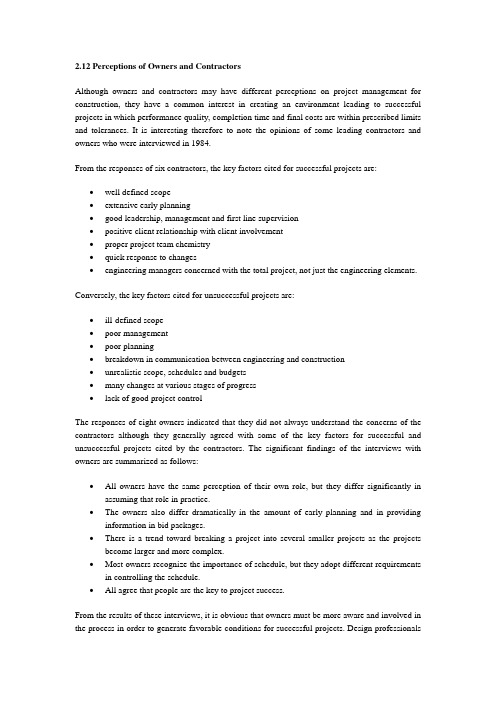
2.12 Perceptions of Owners and ContractorsAlthough owners and contractors may have different perceptions on project management for construction, they have a common interest in creating an environment leading to successful projects in which performance quality, completion time and final costs are within prescribed limits and tolerances. It is interesting therefore to note the opinions of some leading contractors and owners who were interviewed in 1984.From the responses of six contractors, the key factors cited for successful projects are:∙well defined scope∙extensive early planning∙good leadership, management and first line supervision∙positive client relationship with client involvement∙proper project team chemistry∙quick response to changes∙engineering managers concerned with the total project, not just the engineering elements.Conversely, the key factors cited for unsuccessful projects are:∙ill-defined scope∙poor management∙poor planning∙breakdown in communication between engineering and construction∙unrealistic scope, schedules and budgets∙many changes at various stages of progress∙lack of good project controlThe responses of eight owners indicated that they did not always understand the concerns of the contractors although they generally agreed with some of the key factors for successful and unsuccessful projects cited by the contractors. The significant findings of the interviews with owners are summarized as follows:∙All owners have the same perception of their own role, but they differ significantly in assuming that role in practice.∙The owners also differ dramatically in the amount of early planning and in providing information in bid packages.∙There is a trend toward breaking a project into several smaller projects as the projects become larger and more complex.∙Most owners recognize the importance of schedule, but they adopt different requirements in controlling the schedule.∙All agree that people are the key to project success.From the results of these interviews, it is obvious that owners must be more aware and involved in the process in order to generate favorable conditions for successful projects. Design professionalsand construction contractors must provide better communication with each other and with the owner in project implementation.3. The Design and Construction Process3.1 Design and Construction as an Integrated SystemIn the planning of facilities, it is important to recognize the close relationship between design and construction. These processes can best be viewed as an integrated system. Broadly speaking, design is a process of creating the description of a new facility, usually represented by detailed plans and specifications; construction planning is a process of identifying activities and resources required to make the design a physical reality. Hence, construction is the implementation of a design envisioned by architects and engineers. In both design and construction, numerous operational tasks must be performed with a variety of precedence and other relationships among the different tasks.Several characteristics are unique to the planning of constructed facilities and should be kept in mind even at the very early stage of the project life cycle. These include the following:∙Nearly every facility is custom designed and constructed, and often requires a long time to complete.∙Both the design and construction of a facility must satisfy the conditions peculiar to a specific site.∙Because each project is site specific, its execution is influenced by natural, social and other locational conditions such as weather, labor supply, local building codes, etc.∙Since the service life of a facility is long, the anticipation of future requirements is inherently difficult.∙Because of technological complexity and market demands, changes of design plans during construction are not uncommon.In an integrated system, the planning for both design and construction can proceed almost simultaneously, examining various alternatives which are desirable from both viewpoints and thus eliminating the necessity of extensive revisions under the guise of value engineering. Furthermore, the review of designs with regard to their constructibility can be carried out as the project progresses from planning to design. For example, if the sequence of assembly of a structure and the critical loadings on the partially assembled structure during construction are carefully considered as a part of the overall structural design, the impacts of the design on construction falsework and on assembly details can be anticipated. However, if the design professionals are expected to assume such responsibilities, they must be rewarded for sharing the risks as well as for undertaking these additional tasks. Similarly, when construction contractors are expected to take over the responsibilities of engineers, such as devising a very elaborate scheme to erect an unconventional structure, they too must be rewarded accordingly. As long as the owner does not assume the responsibility for resolving this risk-reward dilemma, the concept of a truly integrated system for design and construction cannot be realized.It is interesting to note that European owners are generally more open to new technologies and to share risks with designers and contractors. In particular, they are more willing to accept responsibilities for the unforeseen subsurface conditions in geotechnical engineering. Consequently, the designers and contractors are also more willing to introduce new techniques in order to reduce the time and cost of construction. In European practice, owners typically present contractors with a conceptual design, and contractors prepare detailed designs, which are checked by the owner's engineers. Those detailed designs may be alternate designs, and specialty contractors may also prepare detailed alternate designs.Example 3-1: Responsibility for Shop DrawingsThe willingness to assume responsibilities does not come easily from any party in the current litigious climate of the construction industry in the United States. On the other hand, if owner, architect, engineer, contractor and other groups that represent parts of the industry do not jointly fix the responsibilities of various tasks to appropriate parties, the standards of practice will eventually be set by court decisions. In an attempt to provide a guide to the entire spectrum of participants in a construction project, the American Society of Civil Engineers issued a Manual of Professional Practice entitled Quality in the Constructed Project in 1990. This manual is intended to help bring a turn around of the fragmentation of activities in the design and construction process.Shop drawings represent the assembly details for erecting a structure which should reflect the intent and rationale of the original structural design. They are prepared by the construction contractor and reviewed by the design professional. However, since the responsibility for preparing shop drawings was traditionally assigned to construction contractors, design professionals took the view that the review process was advisory and assumed no responsibility for their accuracy. This justification was ruled unacceptable by a court in connection with the walkway failure at the Hyatt Hotel in Kansas City in 1985. In preparing the ASCE Manual of Professional Practice for Quality in the Constructed Project, the responsibilities for preparation of shop drawings proved to be the most difficult to develop. [1] The reason for this situation is not difficult to fathom since the responsibilities for the task are diffused, and all parties must agree to the new responsibilities assigned to each in the recommended risk-reward relations shown in Table 3-1.Traditionally, the owner is not involved in the preparation and review of shop drawings, and perhaps is even unaware of any potential problems. In the recommended practice, the owner is required to take responsibility for providing adequate time and funding, including approval of scheduling, in order to allow the design professionals and construction contractors to perform satisfactorily.Example 3-2:Model Metro Project in Milan, Italy [2]Under Italian law, unforeseen subsurface conditions are the owner's responsibility, not the contractor's. This is a striking difference from U.S. construction practice where changed conditions clauses and claims and the adequacy of prebid site investigations are points of contention. In effect, the Italian law means that the owner assumes those risks. But under the same law, a contractor may elect to assume the risks in order to lower the bid price and thereby beat the competition.According to the Technical Director of Rodio, the Milan-based contractor which is heavily involved in the grouting job for tunneling in the Model Metro project in Milan, Italy, there are two typical contractual arrangements for specialized subcontractor firms such as theirs. One is to work on a unit price basis with no responsibility for the design. The other is what he calls the "nominated subcontractor" or turnkey method: prequalified subcontractors offer their own designs and guarantee the price, quality, quantities, and, if they wish, the risks of unforeseen conditions.At the beginning of the Milan metro project, the Rodio contract ratio was 50/50 unit price and turnkey. The firm convinced the metro owners that they would save money with the turnkey approach, and the ratio became 80% turnkey. What's more, in the work packages where Rodio worked with other grouting specialists, those subcontractors paid Rodio a fee to assume all risks for unforeseen conditions.Under these circumstances, it was critical that the firm should know the subsurface conditions as precisely as possible, which was a major reason why the firm developed a computerized electronic sensing program to predict stratigraphy and thus control grout mixes, pressures and, most important, quantities.3.2 Innovation and Technological FeasibilityThe planning for a construction project begins with the generation of concepts for a facility which will meet market demands and owner needs. Innovative concepts in design are highly valued not for their own sake but for their contributions to reducing costs and to the improvement of aesthetics, comfort or convenience as embodied in a well-designed facility. However, the constructor as well as the design professionals must have an appreciation and full understanding of the technological complexities often associated with innovative designs in order to provide a safe and sound facility. Since these concepts are often preliminary or tentative, screening studies are carried out to determine the overall technological viability and economic attractiveness without pursuing these concepts in great detail. Because of the ambiguity of the objectives and the uncertainty of external events, screening studies call for uninhibited innovation in creating new concepts and judicious judgment in selecting the appropriate ones for further consideration.One of the most important aspects of design innovation is the necessity of communication in the design/construction partnership. In the case of bridge design, it can be illustrated by the following quotation from Lin and Gerwick concerning bridge construction: [3]The great pioneering steel bridges of the United States were built by an open or covert alliance between designers and constructors. The turnkey approach of designer-constructor has developed and built our chemical plants, refineries, steel plants, and nuclear power plants. It is time to ask, seriously, whether we may not have adopted a restrictive approach by divorcing engineering and construction in the field of bridge construction.If a contractor-engineer, by some stroke of genius, were to present to design engineers today a wonderful new scheme for long span prestressed concrete bridges that made them far cheaper, he would have to make these ideas available to all other constructors, even limiting or watering them down so as to "get a group of truly competitive bidders." The engineer would have to make sure that he found other contractors to bid against the ingenious innovator.If an engineer should, by a similar stroke of genius, hit on such a unique and brilliant scheme, he would have to worry, wondering if the low bidder would be one who had any concept of what he was trying to accomplish or was in any way qualified for high class technical work.Innovative design concepts must be tested for technological feasibility. Three levels of technology are of special concern: technological requirements for operation or production, design resources and construction technology. The first refers to the new technologies that may be introduced in a facility which is used for a certain type of production such as chemical processing or nuclear power generation. The second refers to the design capabilities that are available to the designers, such as new computational methods or new materials. The third refers to new technologies which can be adopted to construct the facility, such as new equipment or new construction methods.A new facility may involve complex new technology for operation in hostile environments such as severe climate or restricted accessibility. Large projects with unprecedented demands for resources such as labor supply, material and infrastructure may also call for careful technological feasibility studies. Major elements in a feasibility study on production technology should include, but are not limited to, the following:∙Project type as characterized by the technology required, such as synthetic fuels, petrochemicals, nuclear power plants, etc.∙Project size in dollars, design engineer's hours, construction labor hours, etc.∙Design, including sources of any special technology which require licensing agreements.∙Project location which may pose problems in environmental protection, labor productivity and special risks.An example of innovative design for operation and production is the use of entropy concepts for the design of integrated chemical processes. Simple calculations can be used to indicate the minimum energy requirements and the least number of heat exchange units to achieve desired objectives. The result is a new incentive and criterion for designers to achieve more effective designs. Numerous applications of the new methodology has shown its efficacy in reducing both energy costs and construction expenditures. [4] This is a case in which innovative design is not a matter of trading-off operating and capital costs, but better designs can simultaneously achieve improvements in both objectives.The choice of construction technology and method involves both strategic and tactical decisions about appropriate technologies and the best sequencing of operations. For example, the extent to which prefabricated facility components will be used represents a strategic construction decision. In turn, prefabrication of components might be accomplished off-site in existing manufacturing facilities or a temporary, on-site fabrication plant might be used. Another example of a strategic decision is whether to install mechanical equipment in place early in the construction process or at an intermediate stage. Strategic decisions of this sort should be integrated with the process of facility design in many cases. At the tactical level, detailed decisions about how to accomplish particular tasks are required, and such decisions can often be made in the field.Construction planning should be a major concern in the development of facility designs, in the preparation of cost estimates, and in forming bids by contractors. Unfortunately, planning for the construction of a facility is often treated as an after thought by design professionals. This contrasts with manufacturing practices in which the assembly of devices is a major concern in design. Design to insure ease of assembly or construction should be a major concern of engineers and architects. As the Business Roundtable noted, "All too often chances to cut schedule time and costs are lost because construction operates as a production process separated by a chasm from financial planning, scheduling, and engineering or architectural design. Too many engineers, separated from field experience, are not up to date about how to build what they design, or how to design so structures and equipment can be erected most efficiently." [5]。
